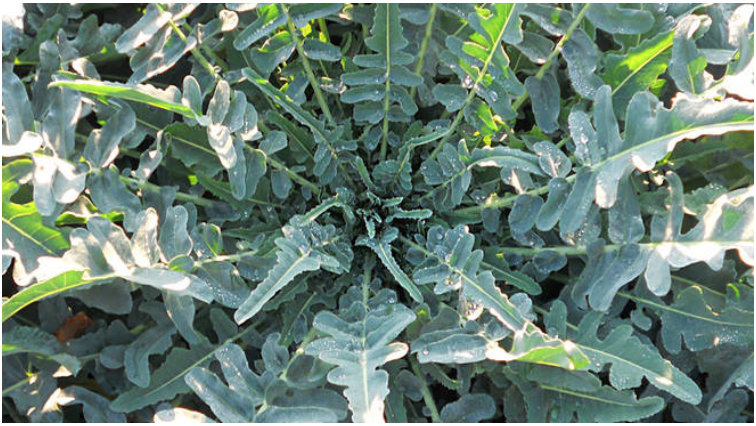Crop: Brassica oleracea L. var. italica Plenk. (Broccoli)
‘Broccolo Fiolaro di Creazzo’ (B. oleracea L. var. italica Plenk.) exhibits a peculiar compact and dense inflorescence. It is characterised by a deep root system and long dark green leaves with undulate marginal incisions. This landrace is particularly appreciated for its leaves and secondary sprouts, called ‘fioi’ (sprouts), that give the name ‘fiolaro’. The origin of this landrace is not clear; its use within the traditional cultivation area (Vicenza, Italy) is reported by the famous German poet Goethe in his manuscript ‘Italianishe Reise’ (1816).
Typically, ‘Broccolo Fiolaro di Creazzo’ is sown indoor in trays at the end of June; when plants reach 10 cm in height they are transplanted into the fields, typically at the end of August. Plantation is carried out in rows 7 cm apart and each plant is spaced 40 cm within rows. At the end of September weeds are removed and fertilizers applied.
The first sprouts can be collected in November; however, the ones considered the best in terms of quality are harvested after the first frost. Plants keep producing sprouts until the end of February/beginning of March. The harvest is carried out manually; The old leaves are removed.
Due to its particular taste the landrace is used in many different culinary preparations, typically: broccoli pie, salads, soups, stuffing for tortellini and soups.
Cultivation System: low-input conditions.
Geographical Information
Country: Italy
Broccolo Fiolaro di Creazzo’ is typically cultivated in the hillside of the municipality of Creazzo (Vicenza Province, Italy; 45°31’55.39’’ N, 11°28’42.89’’) called ‘Lessini Orientali’. The areas in which the production is currently carried out are characterised by good drain abilities. Its cultivation is carried out in the districts of Rivella-Becco d’Oro and Rampa also known as ‘Terre bianche’ (literarily ‘white lands’).
Farmer(s) description:
Farmers are grouped in the agricultural society ‘FIOI Società Agricola Produttori del Broccolo Fiolaro di Creazzo’. The society groups eight farmers. No information is available about the average hectarage. Each farmer destinate a part of their farm surface to the cultivation of this landrace.
Propagation system: Seed, cross-pollination
Multiplication procedures and consequences on landrace diversity:No information is available about the multiplication procedures. ‘FIOI Società Agricola Produttori del Broccolo Fiolaro di Creazzo’ oversees the multiplication that it appears to be crucial to ensure quality and distinctiveness of the product.
Management plan existence:The landrace management relies completely on activities carried out by the farmers within the cultivation area. However, all the activities, including the multiplication procedures are overseen by ‘FIOI Società Agricola Produttori del Broccolo Fiolaro di Creazzo’ which gives technical support.
Added Values
‘Broccolo fiolaro di Creazzo’ has a rich local market. However, no official data is available on the market price and the overall turnover.
Others (e.g. commercial/geographical brands or special traits):This landrace has been also recognized as ‘Prodotto Agroalimentare Tipico’ (PAT, literally Typical Food Product) by the Italian Ministry of Agriculture and Forestry through technical support of Region Veneto. The PAT recognition is based on evidences that demonstrate the use of a landrace (or a processed foodstuff) in a certain area for at least 25 years.
In recent years, ‘Broccolo Fiolaro’ also caught the interest of the ‘Slow Food’ foundation that included it into a group of products called ‘the Ark of Taste’; this initiative aims at drawing attention on products at risk of extinction by inviting people to take action in order to protect them.
The cultivation methods and phases, that were part of the local oral tradition, were formalised into written guidelines that farmers need to endorse in order to be part of the agricultural society. The above-mentioned agronomical practices are analogous to the ones used under organic farming systems and thus constitutes an additional value for the final product.
Finally, FIOI Società Agricola Produttori del Broccolo Fiolaro di Creazzo recently implemented a website in which an important section reports useful information on the landrace (http://www.broccolofiolaro-fioi.it/).
Many activities related to the genetic morpho-phenologic characterisation were carried out at the University of Udine (Department of Agriculture and Environmental Sciences) in the years 2000s (Vischi et al. 2008).
The on-farm conservation of this landraces contributed to preserve agronomic techniques and cultural heritages of the past. ‘Broccolo Fiolaro’ represents a successful case of clever valorisation of a landrace.
Uncertain. As this landrace is not registered as conservation or amateur variety, to have access to the resource please contact: Produttori Broccolo Fiolaro di Creazzo (https://www.broccolofiolaro-fioi.it/index.php/contatti)
Case study provided by Dipartimento di Scienze Agrarie, Alimentari e Ambientali (DSA3), Università degli Studi di Perugia (UNIPG), Italy.
Most of information was retrieved through bibliographic and internet search.
- Vischi M, Fiori M, De Paoli E, et al (2008) Broccoli ‘Fiolaro’ (Brassica oleracea) an endangered typical Italian cultivar. A genetic analysis by SSR markers. Plant Genet Resour Characterisation Util 6:215–221. doi: 10.1017/S1479262108994193
